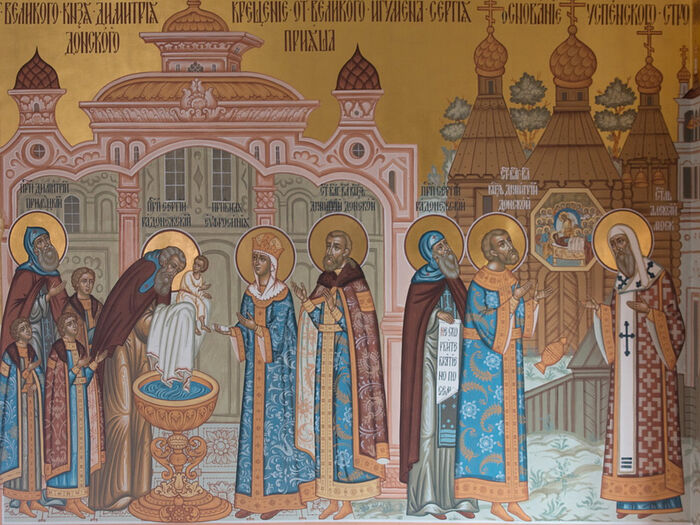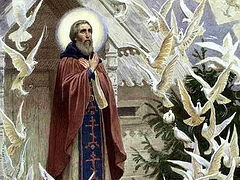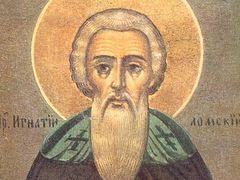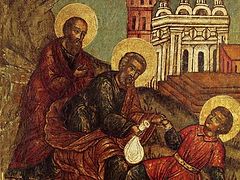Since the fourteenth century, the Grand Princely couple of Sts. Dmitry Donskoy and Eudoxia of Moscow has been an example of the harmonious combination of successful state governance, when the unification of the lands, and not a struggle for power stood at the forefront, with care for their own family. Their large, faithful, and loving family shows us the heights and holiness of motherhood and fatherhood, which are inseparable from one another.
The holy spiritual father and his spiritual children
The closest spiritual ties connect this family with the great luminary of the Russian land—St. Sergius of Radonezh. He baptized both Grand Prince Dimitry himself, as well as his two sons. The foundations of the personal sanctity of Dimitry and Eudoxia were laid by the works of St. Alexei, the Metropolitan of Moscow, and St. Sergius. In these great saints’ blessing of the Russian land can be seen the main reason why this union can be called, without any exaggeration, an ideal Christian marriage. The entire life of the Grand Princely couple played out under the spiritual guidance of these holy ascetics. The instructions of St. Sergius, which have become a treasury of spiritual wisdom, undoubtedly had tremendous influence on the upbringing of the princely children.
After his first encounter with St. Sergius, the Right-Believing Prince Dmitry became one of the saint’s faithful and obedient disciples. The Russian tsars and grand princes would then go to the Holy Trinity-St. Sergius Lavra on the path laid down by the holy Grand Prince Dmitry.
Under the vigilant care and paternal guidance of St. Alexei and St. Sergius, the Russian land, exhausted by strife between the appanage princes, began to gradually unite. Perhaps not immediately, but they submitted to the authority of the prince of Moscow, and the people became conscious of the need to come together to throw off the hated Mongol-Tatar yoke. Long before Mamai, Holy Rus’ was captured by Batu Khan. Kiev—the mother of Russian cities—was almost completely destroyed. The Caves Monastery, the Tithes Church, and other churches were plundered. Rus’ lay in ruins, and many fell into despair.
In his book, The Return of Eudoxia: The Life of St. Eudoxia, Named Euphrosynia in Monasticism, the Grand Princess of Moscow, Leonid Bamblevsky writes:
It became clear that without unity, which could be found only in a common faith in the Resurrected Christ, it was impossible to throw off the hated yoke; only in unity with God—the true power of the people, for in the words of the Apostle, if God is with us, who can be against us? (Rom. 8:31).
This is how St. Sergius of Radonezh taught the Right-Believing Dmitry and other princes, trying to reconcile the warring parties.
This idea of national unity deeply penetrated the Right-Believing Prince Dmitry who sought to liberate the people from the burdensome yoke of the Horde. Gradually, he gathered around himself princes who were ready to sacrifice their power and glory for the sake of the salvation of the fatherland. In the days of trials and wars, seeing the prayerful podvigs of their princes, the whole of the people arose to common prayer, entreating God for protection and patronage. And the Lord did not put the hopes of His children to shame, granting the pious Russian army a glorious victory at Kulikovo Field on the feast of the Nativity of the Most Holy Theotokos, September 8/21, 1380. Now they all knew that there is no enemy they couldn’t overcome with God’s help.
St. Sergius of Radonezh’s authority was so high, and his spiritual ties with the family of the Right-Believing Grand Prince Dmitry Donskoy and the most prominent boyars and highest Church hierarchs so close that he significantly influenced both the Church and political affairs of his time.
During the reign of the Grand Princely couple of Sts. Dmitry and Eudoxia, there began the spiritual rebirth of the fatherland. Christian holiness became the ideal for Muscovite Rus’. Leonid Bamblevsky writes:
Faith in God, inner spiritual strength, and the help and intercession of the saints—this was the foundation on which the new united Russian state began to be built… Orthodoxy began to spread from northern Rus’, with the Holy Trinity-St. Sergius Monastery at the center, and St. Sergius of Radonezh as the guide and spiritual father of all of Rus’. And if the center was the monastery of St. Sergius, then at the public level, the “builders” of the house of the Russian state were the Grand Princely couple, Sts. Dmitry and Eudoxia.
In 1380, during a formidable battle with the army of the Horde, Muscovite Rus’ withstood the test of endurance thanks only to the enduring alliance of the spiritual and secular authorities. And this should be an example for us to emulate today.
The union of Grand Prince Dmitry and Eudoxia is one of the most striking examples of a large Orthodox family, whose love was poured out upon all residents of the Moscow Princedom. Their constant care for those in need, for destitute victims of fire, for the sick and suffering won the universal love of the people, who saw in Sts. Dmitry and Eudoxia their helpers and intercessors.
Through St. Alexei, God Himself blessed this ideal spousal union, based on Christian values. The life of the Grand Princely family proceeded according to the Gospel laws. The spouses gave an example of piety, mercy, and love. Their extraordinary love for God distinguished both spouses from their very childhoods.
The Right-Believing Prince
On May 19/June 1, we celebrate the memory of the holy Right-Believing Prince Dmitry Donskoy, who was glorified among the saints in 1988, in the year of the celebration of the 1,000th anniversary of the Baptism of Rus’. His name is inextricably bound up with his victory at the Battle of Kulikovo.
The holy Grand Prince Dmitry was born in 1350 in the family of Prince Ivan the Fair and Princess Alexandra. Left without a father at age nine, he was brought up under the guidance of St. Alexei, the Metropolitan of Moscow, who was greatly assisted in this by St. Sergius of Radonezh. Thanks to his mentors, the Right-Believing Prince Dmitry developed the good habit of not starting any work without the blessing of God. Reared in deep faith, he lived, in the words of the chronicler, “doing all things with God and fighting for Him.”
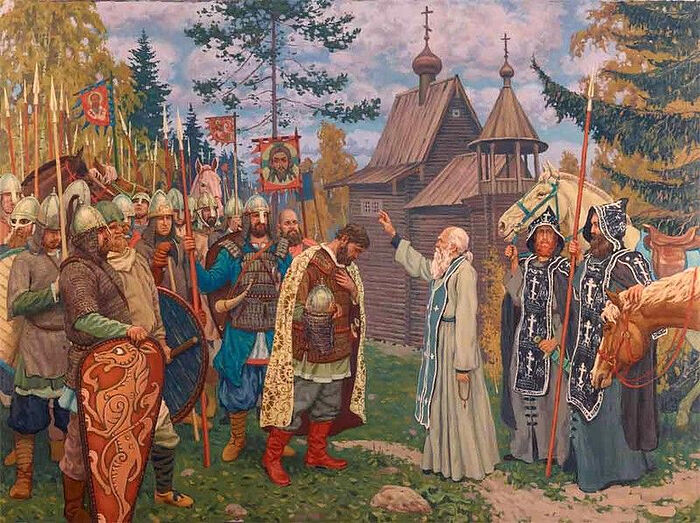 St. Sergius blessed St. Dmitry for the Battle of Kulikovo. Artist: Pavel Popov
St. Sergius blessed St. Dmitry for the Battle of Kulikovo. Artist: Pavel Popov
Prince Dmitry’s Christian piety was combined with his talent as an outstanding statesman. Having occupied the Grand Princely throne at the age of twelve, he dedicated himself to uniting the Russian lands and liberating Rus’ from the Tatar-Mongol yoke. The young prince grasped the art of Moscow politics, which consisted of a combination of strength and mercy.
Throughout nearly the entirety of his Grand Princely reign, he had to wage incessant wars with numerous enemies, both external and internal. He realized early on that the national cause of the rise of Moscow was impossible without arranging his own home. His marriage with Eudoxia can be compared in its strength and reliability to the walls of the white-stoned Kremlin, erected by Prince Dmitry after a fire in Moscow.
Until the end of his days, he never stopped communicating with St. Sergius, entreating his prayers for his family. Historians believe that Grand Princess Eudoxia, who ardently aspired to holiness and the monastic life, not only met the abbot of the Russian land, but also became his sole female disciple.
In the spring of 1389, sensing his approaching death, St. Dmitry sent for St. Sergius, who became the main witness when the Grand Prince drew up his spiritual will.
“My children, live together in harmony and obey your mother in all things… Whichever son ceases to obey his mother shall not have my blessing upon him… I am departing to God, and I entrust you to God and your mother: Be ever under the fear of her… Fear God; love your boyars, and be friendly to all your servants. And you, boyars … serve my princess and my child…”—thus spoke the dying Right-Believing Grand Prince Dmitry Donskoy.
In his spiritual letter, he gave his children and progeny a lasting command that the eldest son should inherit the Grand Princely throne after his father, thereby establishing a new order of succession, ruling out any disputes or claims on the part of the deceased prince’s brothers. The preservation of this important decree, to which not only Moscow, but all of Russia is forever indebted for the strengthening of a single autocratic power, was entrusted by the providence of God to St. Sergius.
Before his death, the Grand Prince wished his relatives, loved ones, boyars, and all of Rus’: “May the God of peace be with you!” What deep meaning is concealed within these words! The whole soul of the holy Grand Prince, who had labored and suffered for the motherland, was poured out in this pious blessing.
Preparing for his transition to the other world, the Right-Believing Grand Prince Dmitry managed with great difficulty to persuade his holy wife not to abandon the duties of the state, not to go to a monastery, as she so desired, but to become co-ruler with their eldest son Vasily. How could a loving wife refuse a dying husband? He was the first in the history of Rus’ to endow his wife with a specific principality.
On May 19/June 1, the Right-Believing Grand Prince Dmitry reposed in the forty-first year of his life. According to tradition, his funeral was served by St. Sergius. The veneration of the Grand Prince as a chosen one of God began in Moscow, but later became widespread, and ended in his glorification as a saint. After Vladimir Monomakh and the Right-Believing Grand Prince Alexander Nevsky, there is no ruler that the Russian people love and honor so highly. St. Dmitry was buried in the Archangel Cathedral next to the tombs of his father, grandfather, and great-grandfather.
Eudoxia-Euphrosynia: goodwill and joy
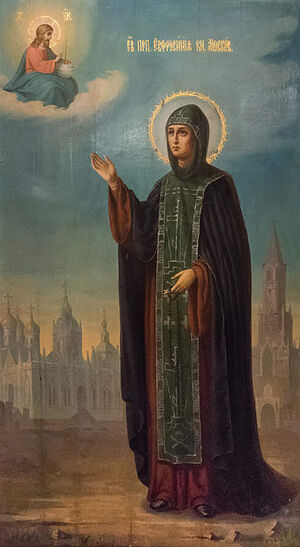 St. Euphrosynia of Moscow After the death of her husband, all the cares of the state and family fell upon the delicate shoulders of Eudoxia. Translated, her name means “goodwill.” Not long before her death, she received the monastic tonsure with the name Euphrosynia, which means “joy.” Her monastic name was very fitting for her, for her life was a great joy for the whole of the Russian land.
St. Euphrosynia of Moscow After the death of her husband, all the cares of the state and family fell upon the delicate shoulders of Eudoxia. Translated, her name means “goodwill.” Not long before her death, she received the monastic tonsure with the name Euphrosynia, which means “joy.” Her monastic name was very fitting for her, for her life was a great joy for the whole of the Russian land.
Despite the many trials sent by God that strengthened her faith, which she loved from childhood, her own life was filled with joy, consisting of love for her husband and children, of family cares and matters of national importance, of works of mercy and unceasing prayer.
A faithful and caring wife, mother of many children, philanthropist, patroness of the needy, and Orthodox Christian, St. Euphrosynia is an ideal and a role model for our contemporaries. How amazingly much the holy Grand Princess did for Muscovites! With her own funds, she built homes for victims of the fire, and majestic stone churches and monasteries; she cared for the poor, the sick, the elderly, and widows and orphans. During her lifetime, people called her mother, and after her death—patroness.
Grand Princess Eudoxia was the daughter of Prince Dmitry Konstantinovich of Suzdal and his wife Anna. Her father long contested the throne with the young Prince Dmitry of Moscow, until he gave his daughter to him in marriage and became his loyal ally. With the blessing of St. Alexei, the wedding was solemnly celebrated in Kolomna on January 18, 1366. Cementing the union of the Moscow and Suzdal Principalities, this marriage was of great importance for the fate of the Moscow state.
More than anything in the world, the future St. Euphrosynia wanted to dedicate her life to God. But by the will of God and the request of her husband, Grand Princess Eudoxia became the first female ruler in the history of Rus’. She ruled Muscovite Rus’ for twenty years, giving her children and her people all her love and care. Only God knows how many tears she shed, begging God for His help. But God Himself had prepared her to unite the podvig of civil service to her fatherland with the monastic podvig, acquiring the Christian royal dignity of man. It’s not without reason that she’s depicted in ancient Russian illuminated manuscripts with a royal crown.
Grand Princess Eudoxia was able to realize her long-standing dream of becoming a nun just before her death. Throughout her entire life, she showed forth the holiness of motherhood.
The children
Different sources have different information about how many children the Grand Princely family had. Leonid Bamblevsky says that we know about twelve children, three of whom died in infancy. The rest of the children pleased their parents with their diligence and perseverance. The names of their three daughters aren’t given in the chronicles, but history has preserved the names of the sons. The firstborn, Vasily, became the Grand Prince of Moscow. Prince Yuri of Zvenigorod built St. Savvas of Storozhev Monastery in his principality, and also built the stone Holy Trinity Cathedral in St. Sergius’ monastery. The other sons were named Peter, Andrei, Ivan, George, and Konstantin.
Grand Princess Eudoxia tried to instill the love of God in her children. From infancy, she took them to church and sang holy prayers at their cradles, and when they grew up, she taught them the foundations of the Orthodox faith. The children were a visible confirmation of the sincere love and warm relations of their parents. They were brought up in special zeal for the works of piety. It’s hard to count how many churches and monasteries were erected to the glory of God by Princes Vasily, Yuri, and Andrei, and St. Dmitry’s other sons.
After the repose of St. Sergius, his nephew and disciple, St. Theodore, abbot of the Moscow Simonov Monastery (later Archbishop of Rostov), became the spiritual father of the family of the Right-Believing Grand Prince Dmitry. He baptized Prince Andrei Dmitrievich. Three edifying epistles to the sons of Prince Dmitry (Vasily, Andrei, and George), written by St. Cyril of White Lake—another disciple of St. Sergius of Radonezh—have come down to our days.
As we can see, the fates of St. Sergius, the Right-Believing Prince Dmitry, and St. Euphrosynia are all very closely linked. Let us turn to them for help, as did our ancestors: “O holy God-pleasers, pray to God for us!”

